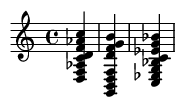The Half-Diminished Chord: Your Guide to Sophisticated Harmony
Summary:
Often called the Minor Seventh Flat Five (m7b5), the half-diminished chord is a cornerstone of musical sophistication. It masterfully balances the moody tension of a diminished triad with the smooth character of a minor seventh. This guide will deconstruct the chord, explore its essential roles in jazz and classical music, and provide you with practical tools for using it in your own playing, writing, and improvisation.
Keywords:
half-diminished chord, minor seventh flat five, m7b5, ii-V-i, jazz harmony, chord theory, Locrian mode, leading-tone chord, music theory, chord function
What Is a Half-Diminished Chord? Construction & Sound
The half-diminished chord is a four-note chord (a seventh chord) built with a specific formula of intervals. Its sound is often described as pensive, mysterious, or complex, but less jarring than its cousin, the fully diminished chord. This unique quality makes it a powerful tool for creating smooth yet compelling harmonic movement.
It's constructed by taking a diminished triad (Root, minor third, diminished fifth) and adding a minor seventh above the root.
Interval Structure: C Half-Diminished (Cø7 or Cm7b5)
- Root: C
- Minor Third: Eb (3 semitones above the root)
- Diminished Fifth: Gb (6 semitones above the root) - This interval, also called a tritone, is the source of the chord's tension.
- Minor Seventh: Bb (10 semitones above the root) - This interval softens the tension of the tritone.
The two common symbols are ø7 (a circle with a slash through it) and m7b5.

Where It Comes From: The Diatonic Origins
The half-diminished chord isn't just a random collection of notes; it occurs naturally (diatonically) within several common scales. Understanding its origins is key to using it effectively.
- Major Scale: It's built on the 7th degree (the leading tone). In C Major (C-D-E-F-G-A-B), the chord built on B is B-D-F-A, which is Bø7. In this context, it's called the leading-tone seventh chord (viiø7) and has a strong pull to resolve to the tonic (Imaj7).
- Natural Minor Scale: It's built on the 2nd degree. In A Natural Minor (A-B-C-D-E-F-G), the chord built on B is B-D-F-A, or Bø7. This is its most famous role as the iiø7 chord.
- Harmonic Minor Scale: It's also built on the 2nd degree. In A Harmonic Minor (A-B-C-D-E-F-G#), the chord on B is B-D-F-A, again Bø7.
- Melodic Minor Scale (Ascending): It appears on the 6th degree. In A Melodic Minor (A-B-C-D-E-F#-G#), the chord on F# is F#-A-C-E, or F#ø7.
The Half-Diminished Chord in Action: Function & Context
The most important aspect of any chord is how it functions. The half-diminished chord is a harmonic workhorse with two primary jobs.
1. The Heart of the Minor ii-V-i (Jazz Harmony)
In jazz, the minor ii-V-i progression is as fundamental as it gets. The half-diminished chord shines as the "ii" chord in this progression. It creates a smooth, descending chromatic line that pulls irresistibly towards the dominant (V) and finally resolves to the minor tonic (i).
Let's look at a ii-V-i in C Minor. The progression is Dm7b5 – G7 – Cm7.

2. The Leading-Tone Chord (Classical and Pop)
As the viiø7 in a major key, the half-diminished chord functions as a predominant or dominant-functioning chord. For example, in C major, the Bø7 contains two notes (D and F) that are also in the V7 chord (G7: G-B-D-F), and its root (B) is the leading tone, which desperately wants to resolve up to the tonic C. This function is common in everything from Bach chorales to modern pop ballads to add a touch of harmonic sophistication.
How to Improvise Over Half-Diminished Chords
When improvising, you need a scale or arpeggio that fits the chord. Here are the most common choices:
- The Arpeggio: The simplest approach is to use the notes of the chord itself: Root, b3, b5, b7. This always works.
- Locrian Mode: Since the chord is built on the 7th degree of the major scale, the 7th mode (Locrian) is a natural fit. For Cø7, you would use C Locrian: C-Db-Eb-F-Gb-Ab-Bb. While technically correct, some players find the Db (the b9) can sound harsh.
- Locrian 2 (The Pro Choice): A more popular choice among jazz musicians is to raise the second degree of the Locrian mode. For Cø7, this gives you C-D-Eb-F-Gb-Ab-Bb. This scale is also the 6th mode of the Eb Melodic Minor scale and is preferred because its natural 2nd (D) leads more smoothly into the following V7 chord.
- The Dominant Connection: Here's a powerful secret. A half-diminished chord can be seen as the upper part of a dominant chord. For example, Dø7 (D-F-Ab-C) contains the 3rd, 5th, 7th, and 9th of a Bb7(b9) chord (Bb-D-F-Ab-C). Thinking this way unlocks a world of dominant language you can use over half-diminished chords.
Half-Diminished vs. Fully-Diminished: A Clear Comparison
It's easy to confuse these two chords, but their difference is crucial. The only change is in the seventh, but it transforms the chord's function and feel.
- Half-Diminished (m7b5): Root - m3 - d5 - m7. Tense but smooth. Often resolves to a minor or dominant chord.
- Fully-Diminished (°7): Root - m3 - d5 - d7. Highly tense and unstable. Almost always resolves to a major or minor chord a half-step up.
Cø7 vs. C°7
Listen to the difference a single semitone makes. The Cø7 has a Bb, while the C°7 has a Bbb (enharmonically an A).

Famous Examples in Music
Once you know what to listen for, you'll hear half-diminished chords everywhere.
- "Autumn Leaves" (Joseph Kosma) : A perfect study. The progression to the relative G minor key is a classic Am7b5 – D7 – Gm7.
- "Black Orpheus" (Luiz Bonfá): This Bossa Nova standard is built around the minor ii-V-i and is filled with half-diminished chords.
- "Stella by Starlight" (Victor Young): The very first chord of this iconic jazz standard is a half-diminished chord (Em7b5 or Gø7, depending on the key).
- "Michelle" (The Beatles): Paul McCartney uses a sophisticated Fm7b5 in the progression following the line "I love you," adding a poignant, continental flavor.
Conclusion: Your Path to Mastery
The half-diminished chord is more than just a theoretical concept; it's a gateway to a richer harmonic vocabulary. Its unique blend of tension and smoothness allows you to craft progressions with emotional depth and elegance. By understanding its construction, function, and application, you've added one of the most versatile and expressive tools to your musical arsenal.
To master it, start by:
- Playing It: Play m7b5 chords in all 12 keys on your instrument. Feel the shape and hear the sound.
- Identifying It: Look for minor ii-V-i progressions in jazz standards and listen for its distinctive sound in all genres.
- Using It: Try substituting a m7b5 for other chords. For example, try replacing the VIm chord in a major key with a viiø7 chord (e.g., in C Major, replace Am with Bø7) and see how it changes the progression.
Embrace the sophistication of the minor seventh flat five. It will elevate your understanding of harmony and unlock new creative possibilities.
References:
Levine, Mark. (1995). The Jazz Theory Book. Sher Music Co.
Russo, William. (1973). Jazz Composition and Orchestration. University of Chicago Press.
Persichetti, Vincent. (1961). Twentieth-Century Harmony. W. W. Norton & Company.
Coker, Jerry. (1997). Elements of the Jazz Language for the Developing Improvisor. CPP/Belwin.
